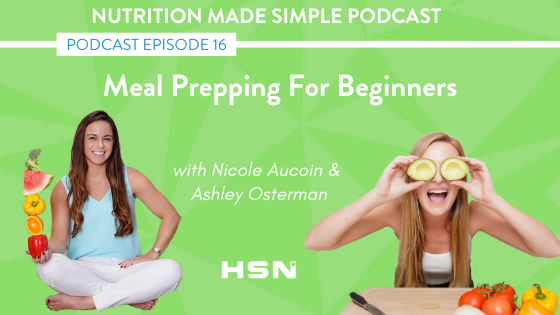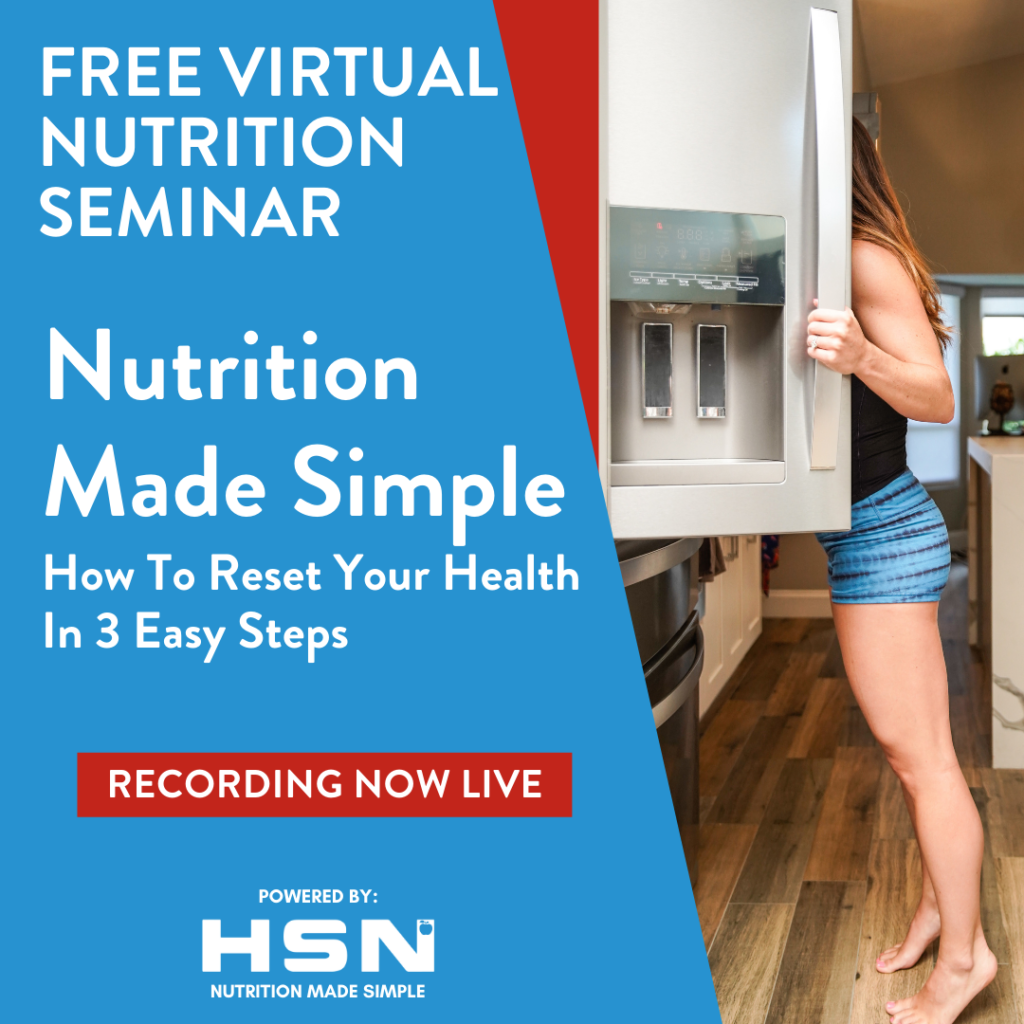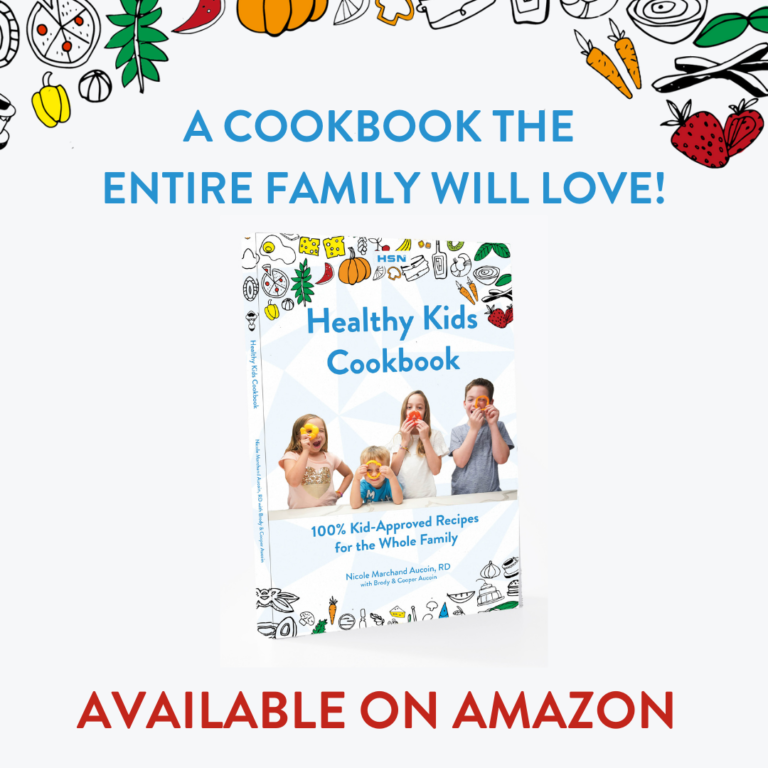Are you interested in learning how to meal prep?
Meal prepping is one of the most valuable skills you can develop to set yourself up for success.
This week, Nicole Aucoin and Ashley Osterman break down the idea of meal prepping into simple and actionable steps. They discuss some of our top efficiency tips and some common mistakes when you first learn how to meal prep!
Whether you are a seasoned meal prepper or just getting started, this episode is for you!
We have an awesome FREE downloadable guide to go along with this episode: Beginners guide to meal prepping!
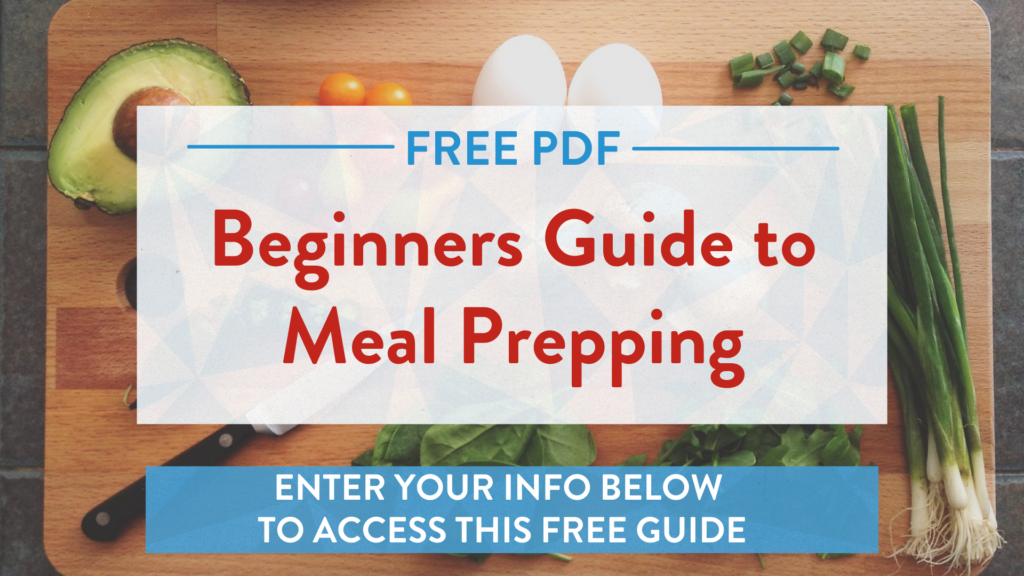
Top Efficiency Tips For Meal Prepping
Tips for beginners in the kitchen
What you really need to set yourself up for success with prepping.
Basics kitchen tools:
- Large size mixing bowl
- Muffin Tin
- Baking Sheet
- Skillet Med-Large Size
- Crock Pot
- Air Fryer (optional)
Create a Plan:
- Choose one crock pot dish, one dish to cook on the skillet, one dish in the oven and maybe a couple sides in the air fryer or on the stove top.
- Prep fruits and vegetables-prep them, wash them, cut them – all that’s left to do is to grab them out of the refrigerator and enjoy them.
- Use 3 compartment containers to store meals. Buy >>here
Create a list:
- Do an inventory of what’s in the fridge and pantry
- Go shopping then plan to prep right after
Easy HSN Recipes to try
These 4 easy recipes, all take different cooking methods and you can do them at the same time, which will make you so efficient in the kitchen.
Egg Roll in a Bowl
3 ingredients and it takes less than 15 minutes to make with absolutely no prep time.
Double Chocolate Overnight Oats
You make them the night or day before, and then they’re grab and go, they’re ready!
Pulled Chicken
Our favorite crockpot recipe – only 3 ingredients, set & forget it!
Meatloaf Muffins
Kids love them, option to add in more hidden veggies. Could be a snack or meal based on portion size.
Common mistakes
Don’t waste time overcooking
Ensuring that you have your meals already pre-portioned is going to help to ensure that you’re not cooking too much and wasting food.
If you find yourself with extra food, portion and freeze the food that way they can last longer as well.
You don’t need to eat the same boring food everyday
Use a staple and use it in different ways. Pair it with different side dishes, make it in different ways, add different spices to it. There’s so many different ways that you can take a staple and modify it to have that variety.
For example, you can use the Crockpot Pulled Chicken recipe in a variety of different ways – with a salad, stuffed sweet potato, tacos, burritos or mexican bowl.
Buying foods that are seemingly healthy
Think about this the next time you see food labeled as low sugar or no sugar added:
- Just because something is marketed as reduced sugar or less sugar, does not mean low sugar.
- Just because something has no added sugar doesn’t mean there’s no sugar. It just means that no sugar or sugar containing ingredient was added during the processing or packaging
- Just because it’s natural sugar does not mean that you can have as much as you want.
Download The Beginners Guide To Meal Prepping and learn how to read nutrition fact labels!
ADDITIONAL PODCAST EPISODES TO LISTEN TO
ARE YOU A GYM OWNER OR NUTRITION COACH?
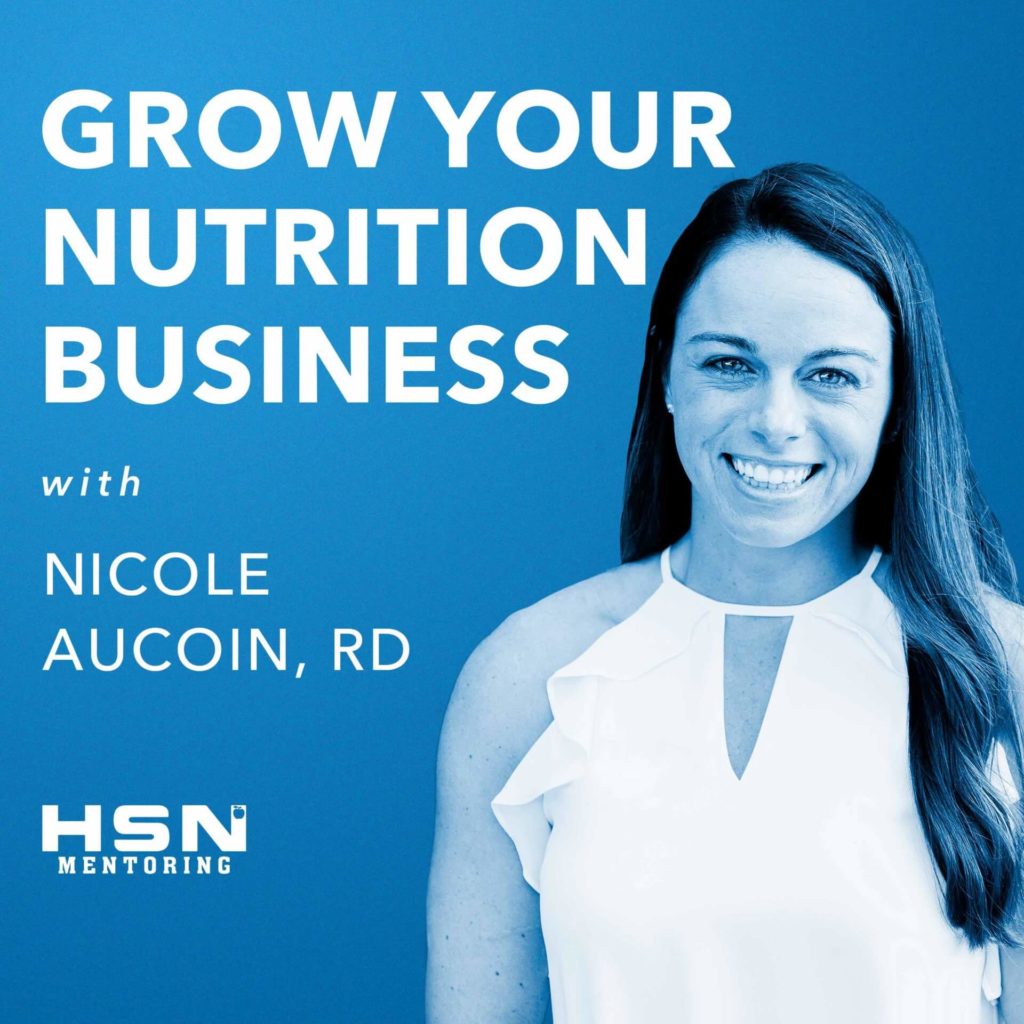
You don’t want to miss the Grow Your Nutrition Business Podcast!
Every week, we provide simple and actionable tips to help gym owners and coaches build a wildly successful nutrition program.
Listen now!
INTRODUCING HIREANUTRITIONCOACH.COM
In this directory, you will find a list of the nutrition coaches and dietitians that use our program, written and overseen by dietitians.
These coaches have gone through coaches evaluations, have ongoing mentoring calls with our experts, and have been nutrition coaching using HSN for a minimum of four months.
Click the link below to find a nutrition coach near you!
Episode Transcript:
Nicole Aucoin (00:04):
Welcome back to the Nutrition Made Simple Podcast. At Healthy Steps Nutrition, we believe something as fundamental as nutrition shouldn’t be complicated, which is why we focus on a simple, habit-based approach when working with clients. I’m your host, Nicole Aucoin, registered dietitian and founder of Healthy Steps Nutrition, CrossFit HSN, and HSN mentoring. I’m also the author of the Healthy Kids Cookbook, 100% kid approved recipes the entire family will love. You can find it on Amazon.
Nicole Aucoin (00:36):
In this podcast, we will be teaching you how to take one step at a time to becoming the healthiest version of yourself. Today, we are talking about a nutrition buzzword, meal prepping. Meal prepping is one of the most valuable skills that you can develop to set yourself up for success. This week, Ashley and I are breaking down the idea of meal prepping into simple and actionable steps. We will also discuss some of our most popular efficiency tips, as well as the common mistakes that we see from people who are first learning how to meal prep. Whether you are a seasoned meal prepper or you are just getting started, this episode is for you.
Nicole Aucoin (01:20):
To go along with this episode, we have an awesome brand new free downloadable guide. It’s a PDF called Beginner’s Guide to Meal Prepping. Click the link in the show notes, and you can download this awesome free guide today. We are also going to be linking some of the easiest recipes that we have on our website so that you can save time and have some delicious, healthy, balanced meals. We’ll get right to this episode, right after this message.
Nicole Aucoin (01:50):
Do you know someone who’s looking to get healthy or someone that’s interested in meal prepping, but unsure where to start? We would love for you to share this podcast with them. Take a screenshot and post it on social media. Please don’t forget to tag @healthystepsnutrition, so your friends can find some of our awesome free help. Also, don’t forget to subscribe so you don’t miss any episodes. Enjoy this episode on meal prepping. Ashley, welcome to the Nutrition Made Simple Podcast.
Ashley Osterman (02:22):
Hey Nicole, thanks for having me.
Nicole Aucoin (02:24):
I’m excited to talk about today’s topic, meal prepping. It’s such a popular topic, and we actually just created a brand new free downloadable guide Meal Prepping for Beginners and we figured let’s make a podcast about this to really bring it to life.
Ashley Osterman (02:39):
Yeah, because I think there’s so much misconception about meal prepping and what it is and what it isn’t.
Nicole Aucoin (02:47):
I can tell you that most people think that meal prepping means spending your entire Sunday, the only day a lot of people have to relax, in the kitchen, prepping the meals for the week, and I don’t know about you, but I don’t want to do that.
Ashley Osterman (02:58):
Oh, absolutely not. And I think other people also think that it’s eating the exact same thing for every single meal, every single day. Chicken, rice, veggies.
Nicole Aucoin (03:07):
I’m definitely not doing that.
Ashley Osterman (03:09):
Me either. I like variety, okay.
Nicole Aucoin (03:12):
But I think there’s a balance between variety of having something different for every meal every day and having a few staples that you can get creative with so you don’t feel like you’re having the same thing every day.
Ashley Osterman (03:23):
Yeah, and being able to really maximize your time in the kitchen so you’re not stuck in there for eight hours on a Sunday. I know personally I spend about two to three hours once a week meal prepping.
Nicole Aucoin (03:35):
All right. So let’s just talk about this and this was an eye-opening experience actually for me, for beginners in the kitchen, when we went and started with the Campbell family to do nutrition coaching with them, we did an inventory of what they had in their kitchen, and there was not large mixing bowls, they had one skillet that was pretty small, they have like a few other things that weren’t in your standard meal prepping environment to set yourself up for success, so I think we need to understand if you are a very beginner, like what do you really need to set yourself up for success with prepping?
Ashley Osterman (04:14):
Yeah. And you don’t need all these fancy gadgets and gizmos and things to meal prep. Really you can have a few basic kitchen utensils and tools and be able to meal prep for success.
Nicole Aucoin (04:25):
Okay. So what are your tools that you would think of when you think of basic tools?
Ashley Osterman (04:31):
Well, you said one of them, I definitely need a large size mixing bowl. I think that’s really important when we’re mixing things together to have for prep, especially when you’re batch cooking. A easy to use muffin tin and a baking sheet. Those are my two go-tos for the oven. Muffin tins are great because they can pre-portion for certain recipes like egg muffins or meatloaf muffins.
Nicole Aucoin (04:53):
Yep.
Ashley Osterman (04:53):
And then a baking sheet is great if we’re baking things like roasting vegetables, doing some Panko chicken. And then you’re going to want to have a really nice skillet of medium to large size, for your stove top. And one thing that I love, you don’t necessarily need it, but it’s one of my favorite tools for meal prepping is a Crock-Pot.
Nicole Aucoin (05:10):
Oh yeah. That was the one tool that I was thinking of. Crock-Pot for sure. You can buy one for like 30 bucks, right? Or less.
Ashley Osterman (05:17):
I think they’re like $20, $25 for a good medium size one these days.
Nicole Aucoin (05:21):
Crock-Pots are awesome because you can set it and forget it. And there are so many super easy recipes, even on our website that are Crock-Pot recipes, you throw all this stuff in and then you let it cook and then you shred it up and it makes quite a bit that you can use for a lot of different recipes, but you’re right. Muffin tin for sure. A baking sheet, a large mixing bowl and a skillet. And if you don’t have like a decent sized skillet, what happens is you have to essentially do double the amount of time cooking because you have to take the meat and or whatever you’re cooking in the skillet and do two batches of cooking it instead of one large skillet where you can cook it all at the same time.
Ashley Osterman (05:58):
Yes. And my last one, it wouldn’t necessarily be needed, but they’re really, really nice to have, and they’ve become so popular over the last few years that they’re very affordable is an air fryer.
Nicole Aucoin (06:08):
Oh yeah. I lo-, it took me way too long to jump on the air fryer bandwagon, but I’m in there, I’m on it. We use the air fryer, I would say five days a week at our house.
Ashley Osterman (06:17):
And to have a variety of utensils and a variety of cooking methods when you are meal prepping, it allows you to be more efficient with your time. So you’re not stuck in the kitchen for a long time. You can do several things at once, and that is a really great strategy.
Nicole Aucoin (06:33):
Okay. So let’s dive into that a little bit. So when you’re planning your meal prep, which is step two. So first step, we got an inventory of what we really need. Then step two, we’re creating this plan. When you are planning what you’re doing, you need to use, you need to make your plan based on your inventory, right? Like if we’re trying to make two Crock-Pot dishes on Sunday, and that’s our only day for a meal prep, and we know each Crock-Pot dish takes like four to five hours. Now we’ve all of a sudden, we’re spending more time than we really need to in the kitchen.
Ashley Osterman (07:06):
Right. So instead of choosing two Crock-Pot dishes, what I would do would be choose one Crock-Pot dish, one dish that I can do on the skillet, one dish I can do in the oven and maybe a couple sides I can do in the air fryer or on the stove top. Really maximize your potential with what you can make in efficiency with your time.
Nicole Aucoin (07:25):
I love that. So planning out, let’s talk about some of the easiest recipes, because beginners, we don’t feel confident in the kitchen. I get it. Like my husband is a way better cook than I am in the kitchen, but I’ve got a few staples up my sleeve that I’m very confident that I can make and they taste great. So let’s talk about some of the staples. Ashley, the first recipe that comes to mind and is our go-to with any beginner is egg roll in a bowl.
Ashley Osterman (07:50):
Egg roll in a bowl is so stinking easy. It is three ingredients and it takes less than 15 minutes to make with absolutely no prep time. There’s no chopping veggies. There’s no washing. There’s nothing. It’s you get the ingredients and you start cooking. So whenever I have a client tell me, “I don’t have time to make a meal.” I said, “Oh, do you have 15 minutes? I’ve got a meal for you, egg roll in a bowl.”
Nicole Aucoin (08:16):
And we’ll link all of these recipes in the show notes, and there’s all of these strategies that we’re talking about today are in the meal prep guide so click the link in the show notes and download that meal prep guide, that’s going to be very helpful for you. So egg roll in a bowl is definitely one. The other one that I really love and our kids absolutely love it is the double chocolate overnight oats.
Ashley Osterman (08:35):
Yes. If you are one of those people who really struggle in the morning for time and you want to have a balanced breakfast, but it’s just seems like there’s no time to do it, overnight oats are your go-to. You make them the night before, day before, and they’re grab and go, they’re ready. You can take it out of the refrigerator, and if you prep them in a ball jar, they even fit in the cup holder in your car.
Nicole Aucoin (08:57):
Yeah, we use little Mason jars for ours in it. They’re absolutely perfect. The secret ingredient that’s not so secret in the double chocolate overnight notes is the Greek yogurt. It makes it taste so creamy, which is not your normal oatmeal consistency.
Ashley Osterman (09:10):
Yeah. It’s so great. It’s such an awesome breakfast or a snack. I love it. It’s a go-to for a quick and easy staple.
Nicole Aucoin (09:16):
Love it. All right. Next couple other recipes that I would say for beginners are really good. My favorite, this is definitely, this is my recipe, Jason does not prep this one because this one’s real easy. I like to take this one. Pulled chicken.
Ashley Osterman (09:29):
Pulled chicken is my favorite Crock-Pot recipe by far.
Nicole Aucoin (09:32):
So three ingredients for this one, chicken breast, taco seasoning, and we use like a spicy taco seasoning, which gives it a little bit more of a kick and then salsa verde, versus the red salsa, and it gives it more of like a zesty flavor and it’s so delicious, but three ingredients. Wash the chicken breast and put the taco seasoning and then layer in the salsa, put it on low for six hours or high for four and you’re good to go.
Ashley Osterman (09:59):
Yeah. Set it and forget it. That’s the best part about the Crock-Pot. Another super easy recipe that is even kid-friendly, I know kids love to make it as well as love to eat it, is the meatloaf muffins.
Nicole Aucoin (10:12):
The cool thing about this one is you can add vegetables into this one and you can’t really taste them. So like we put peppers in there and they’re really delicious, great option for a snack or putting two together if you’re an adult for a meal, along with some vegetables and some starch, but that’s a really, really good option. Okay. We just named four recipes, one Crock-Pot, one that’s on the skillet, overnight oats, which you don’t cook it all, you just put it in the fridge, and then meatloaf muffin. So we use the utensils in our, what we described in the top part and nothing required something else to be cooked first, and I think when people take a really long time to meal prep it’s ’cause they have to wait for something to get done to start the next thing.
Ashley Osterman (10:56):
Yeah. Or they have to think about, “Okay, well this is going in the oven, and then I have another thing in the oven. I have to this one on the skillet. But if you do those four recipes that we just recommended, all of them take different cooking methods and you can do them at the same time, which will make you so efficient in the kitchen.
Nicole Aucoin (11:13):
I love it. So we create a plan, right? We really have to create a list, a grocery list. So, going to the grocery store, you definitely do not want to go to the grocery store without a list ’cause you’re going to get all the things, especially if you’re really hungry.
Ashley Osterman (11:27):
Yes. If you fail to plan, you are planning to fail. And I have been victim of this before. Oh, I just need a few things. I’m going to the store. I don’t need to write it down. What happens? You buy things you don’t need, and you forget the two things you do need. So making a list and just like Nicole said for tip number one, doing an inventory of your utensils and what you have to cook with in your kitchen, you also want to do an inventory of what’s in your refrigerator and what’s in your pantry.
Nicole Aucoin (11:50):
I think the worst thing is you go to make a recipe and you’ve got all the ingredients except one ingredient and it’s like, darn it, now I got to go back to the store, and now I’ve got more time that I’m wasting to meal prep, and now it’s taking six hours and it should’ve taken me four hours. So create a list, set yourself up for success. The next thing, and this is, Ashley, something you talk a lot about. When you go shopping, plan to prep right after, and I think a lot of people don’t do that.
Ashley Osterman (12:16):
Yeah. I do this myself. I practice what I preach. Every Sunday, I have it blocked off in my calendar. I have it as an appointment with myself. I have my time where I go shopping. And then two to three hours after I shop, I come home and I prep.
Nicole Aucoin (12:29):
One of the things that I love prepping, we do raw peppers in our house as a vegetable. The kids love them. We love them. Lunches, snacks, like we put, at any time really, but we’ll get a ton of raw peppers and I’ll cut them up right after and portion them. So I know I just need to grab one bag and then I’m good to go. And now my kids’ lunches are technically, already started to be prepped and made because we’ve prepped the peppers.
Ashley Osterman (12:57):
Yes, absolutely. And then going back, I’m going to keep harping on this, making the most of your time, being efficient. While things are cooking, while you have your chicken in the Crock-Pot, while you have your meatloaf muffins in the oven, you can be washing and cutting and prepping your fruits and vegetables. And when we do that, Nicole, you had a great suggestion. Pre-portion them in baggies or put them in clear containers. Put them at eye level in the refrigerator. More times than not, we have great intentions and we go to the store and buy all these fresh fruits and vegetables and they go to waste because they’re in our produce drawer. We don’t see them. We never have the time to take them out, to wash them, to get them ready. So if you take that time, you prep them, you wash them, you cut them, all that’s left to do is to grab them out of the refrigerator and enjoy them.
Nicole Aucoin (13:43):
One of the things that we give our nutrition clients is those three compartment containers, right? Like I love those three compartment containers ’cause then it’s easy. All you have to do is grab a container, heat it up for lunch, especially, even if you’re working from home or not, like the office that we’re recording this podcast out of, is in my house. My kitchen is 10 feet away, but I have my lunches already done so it’s easy for me to pop it out, heat it up instead of doing all of this stuff, to get my lunch ready.
Ashley Osterman (14:14):
And those three compartment containers are so great because it helps you with the portion to stay on track. They mimic our plate method. We’re doing half of the container, non starchy veggies. So whether you roasted some broccoli, put some raw peppers in there or did a salad, then a quarter of our container is going to be our protein. Maybe we have a couple of meatloaf muffins or some shredded pulled chicken. And then a quarter of our container is going to be our starch. Maybe I have some rice or maybe I have some sweet potatoes or some fruit.
Nicole Aucoin (14:42):
I love it. So we’re shopping, we’re prepping and we’re portioning our food and just planning it to get it all done will really help to ensure that you’re actually eating what you buy. No one wants to waste money on food that they’re not going to eat. Right.
Ashley Osterman (14:57):
Absolutely. And you know, when it comes to meal prepping for beginners, there are some common mistakes that we tend to see.
Nicole Aucoin (15:05):
I think the first one is funny ’cause it, we have all the best intentions, right? When we jump on the meal prepping train, we jump on, the train is going a hundred miles an hour. We end up cooking way too much, and then we throw out food and then we’re frustrated that we wasted this money and then we end up wanting to not do it, right? So you have to be intentional with what you plan and if you know you have a lunch or something that you have to do to go out, like make sure that you’re not cooking extra food, and then it goes to waste. So planning ahead and making sure that you have your meals already pre-portioned is going to help to ensure that you’re not cooking too much and wasting food.
Ashley Osterman (15:42):
Yeah and if you are one of those people who do love to batch cook, but maybe it’s just you or you and a partner at home, remember you can also portion and freeze foods, that way they can last longer as well.
Nicole Aucoin (15:53):
I love that. So one of the things that I personally love doing when meal prepping and you said, your favorite Crock-Pot dish is pulled chicken, definitely ours too, is using the same thing, different ways. So it doesn’t feel like you’re having grilled chicken, broccoli and rice for five days in a row, you can have the pulled chicken, but then put it different ways, like stuffed sweet potato, on a salad.
Ashley Osterman (16:19):
What else?
Nicole Aucoin (16:19):
Tacos.
Ashley Osterman (16:20):
Burrito.
Nicole Aucoin (16:21):
A Mexican bowl.
Ashley Osterman (16:22):
Zucchini nachos.
Nicole Aucoin (16:24):
I mean, there’s so many different options that you can do so you don’t feel like you’re having the same food every day. And I think that’s an important thing because, let’s give egg muffins for an example, right? Like a lot of our clients will prep egg muffins, but they’ll put different vegetables in, they’ll put different things in so it doesn’t feel like they’re having the same thing every single week. You switch up the flavors a little bit.
Ashley Osterman (16:46):
Yeah, absolutely. It’s such a great strategy. Variety is a spice of life. I love food. I love enjoying food and don’t think, that’s another common mistake, don’t feel like, ’cause you have to meal prep, you’re going to be eating the same thing every single day. Get creative. Use a staple and use it in different ways. Pair it with different side dishes, make it in different ways, add different spices to it. There’s so many different ways that you can take a staple and modify it to have that variety.
Nicole Aucoin (17:14):
Pulled chicken is one of the easiest ways to, like make pulled chicken as a staple and then use it in different things.
Ashley Osterman (17:20):
Oh, one of, by far the easiest for beginners, pulled chicken, take that recipe and then see what you come up with.
Nicole Aucoin (17:27):
All right, let’s talk about the next thing. Ashley, you just made a resource that we started giving clients and talking through with clients, you know the marketing claims.
Ashley Osterman (17:36):
Yes. The last mistake we talk about with our beginning meal prepping clients is buying foods that are seemingly healthy. And guys here’s the thing. Food product marketing is a multi-billion dollar industry. There are people who are paid buku bucks to trick you with their marketing schemes. They place products certain places so that you will buy them. They have appealing packaging so you will buy them, and they have confusing nutrition content claims so you will buy them thinking they’re healthy. And I think one of the biggest ones that we see when it comes to working with clients, doing pantry clean-outs, looking at nutrition facts label of seemingly healthy foods are sugar claims.
Nicole Aucoin (18:26):
All right. This one gets everybody because you think like, “Oh, reduced sugar, less sugar. Like awesome. That sounds great.” But if it’s an Oreo that has a lot of sugar and then a reduced sugar one, it’s not that it doesn’t have a lot of sugar still, it just has less than the original amount, specifically 25% less.
Ashley Osterman (18:45):
Yes. So just because something is marketed as reduced sugar or less sugar, does not mean it’s low sugar. I’m going to say that again. Just because something is marketed as reduced sugar or less sugar, does not mean low sugar. What that means is it has 25% less sugars than the original product. So if your original product has a hundred grams of sugar, it has 75 grams of sugar. That one gets everybody.
Nicole Aucoin (19:14):
Yes. The other thing is the no added sugar one, that’s a good one, right? ‘Cause there’s a lot of natural sources of sugar.
Ashley Osterman (19:23):
Yeah. Sugar is inherently a part of a lot of products. It’s natural. So just because something has no added sugar doesn’t mean there’s no sugar. It just means that no sugar or sugar containing ingredient was added during the processing or packaging. So a dried fruit could have no added sugar, but fruit inherently has sugar in it. So there is sugar in the product, just none was added during the processing.
Nicole Aucoin (19:51):
And I want to be really, kind of clear with our recommendations here. So it doesn’t mean that you can’t have anything that says, or that has sugar in it. That’s not what we’re saying, but you definitely want to be mindful of what you’re eating and how much sugar it has in it and mindful of the portions. Just because, let’s give dried fruit, let’s give raisins for an example. Raisins have a lot of sugar in them, even if it’s not added, right?
Ashley Osterman (20:16):
Yeah. Mm-hmm (affirmative).
Nicole Aucoin (20:17):
So giving your child an entire giant bag of raisins and letting them eat however much they want, is a lot of sugar they could be consuming at one time and sugar, all types of sugar still react the same in the body. You still have that inflammatory response, your blood sugar still goes up. Your pancreas still has to create a lot of insulin. You have this inflammatory response to get your blood sugar down and if it’s really high, and then it goes really low that’s when we get those mood swings or the energy crashes. So just because it’s natural sugar does not mean that like, okay, we can have as much as we want.
Ashley Osterman (20:52):
Absolutely. Just be mindful. I think the take home message here is things will seemingly look healthy because the way they’re packaged, where they’re placed, what the health claims are on them, but you need to empower yourself and read nutrition facts labels to make sure that what is actually in them aligns with their goals. I have been tricked, I think we all have been tricked. For me it was the individual oatmeal packets. I grabbed what looked like a very healthy high protein oatmeal that had individual packets, get home and I start reading it, and sugar is the second ingredient. Well, if you didn’t know, the ingredients list is in order of how much of an ingredient is in the product. So the first ingredient is the number one, most abundant ingredient in the product, and second is the second and so forth. So sugar was the second most abundant ingredient in that product. I was tricked, it looked healthy, high protein. Will I do it again? No. I learned my lesson.
Nicole Aucoin (21:50):
There are fruit snacks in the Campbell’s house when we raided their pantry, just to see like, “All right, let’s look at this, let’s teach you how to read a nutrition facts label.” And on the front of the fruit snacks was a giant thing that said like great source of vitamin C. And right now people want a lot of vitamin C. I get it, right. So Clark, the dad was like, “These are awesome, right? ‘Cause it says great source of vitamin C.” I’m like, “Well, let’s just take a look on the backside and look at the nutrition facts label,” and the ingredients label, two of the four top ingredients were sugar.
Ashley Osterman (22:21):
Yeah. So yes, it might’ve been a great source of vitamin C, but we’re also eating a lot of added sugar in that product as well too. And you know, it’s just not the sugar products that are seemingly healthy. We know cauliflower is a very, very popular substitution for higher carbohydrate foods these days. You see cauliflower everywhere, mashed potatoes, cauliflower taco shells, cauliflower breaded chicken. I know Nicole, you’ve got a good story about cauliflower.
Nicole Aucoin (22:51):
Oh yeah. You know we’ve all been tricked. We’ve all been there. Even the most educated people have been tricked. So I got some cauliflower pizza at one point and I was like, “Oh, this can be awesome.” And then my husband got a thin crust pizza.
Ashley Osterman (23:03):
Okay. Yeah, so cauliflower for you, thin crust for J.
Nicole Aucoin (23:06):
Yeah. So we pull them out and I open them up. We’re going to have pizza one night and we made a salad and the kids and we’re all there, and I was like, “Let me just look at the nutrition facts label, let me like look and compare the two.” It was more carbohydrates in the cauliflower pizza than the thin crust pizza.
Ashley Osterman (23:24):
Yeah. So just because something is labeled and looks seemingly healthy, like cauliflower in the pizza crust, doesn’t necessarily mean it’s the best thing to align with your goals. So guys, I empower you to learn how to read a nutrition facts label. Don’t just take health claims packaging for face value. Investigate, really take the time and look because food product marketing is very, very tricky and we’ve all been tricked. But once you know now you know.
Nicole Aucoin (23:53):
I love that. And Ashley, we have a whole tutorial of how to read a nutrition facts label in the Meal Prepping for Beginners Guide.
Ashley Osterman (24:01):
Yes.
Nicole Aucoin (24:01):
So if you click the link in the show notes and you download that guide, you’re going to have all these steps we talked about today in a free guide, as well as the how to read a nutrition facts label. So highly recommended that you take the minute to click the link in the show notes and get that guide so you can empower yourself to become the healthiest version of yourself, and it really comes from knowledge.
Ashley Osterman (24:21):
Absolutely. So as a quick recap, if you are looking to meal prep as a beginner, first things first take an inventory. What do you have in your kitchen and what do you need? Keep in mind that using simple, easy tools to be efficient is going to really set yourself up for success. Secondly, you want to create a plan, go to healthystepsnutrition.com, look at our free downloadable guide. Look at our easy recipes that we talked about. Egg roll in a bowl, overnight oats, pulled chicken and meatloaf muffins. Next, you want to create a list, make sure that you inventory what you have and what you need to buy from the grocery store. And finally, make the time to shop and prep. Shopping and prepping is so important. Schedule that time out and don’t forget to utilize pre-portion containers and we’ll link the three compartment containers in the show notes.
Nicole Aucoin (25:14):
Thanks Ashley.
Nicole Aucoin (25:21):
I’m sure most people have heard this quote before. Failing to plan is planning to fail. I could not agree with that more. Meal prepping is a vital skill and as Ashley and I said, there are some efficiency tips to help you save time and create balanced meals so that you can set your week up for success. I think we’ve all been there. Long day, nothing made at home and take out or a drive through just sounds so much easier. Yes it is but is it really helping you get one step closer to your goals? Don’t forget to click the link in the show notes so you can get that awesome downloadable guide, Beginner’s Guide to Meal Prepping. Think of this as like a do it yourself version. It’s going to give you all of the tools written out that we talked about in this episode and you can apply it to create a plan for success.
Nicole Aucoin (26:11):
This will help you set yourself up for success, but you might be thinking I need a little bit more. I want a guide to help me based on my lifestyle, my preferences, my goals, and really create a customized plan to help you. We would love to help you. You can work with a dietician or a nutrition coach at our CrossFit HQ location, or you can find a nutrition coach near you. Go to hireanutritioncoach.com and you can find a healthy steps nutrition coach near you. I hope you enjoyed this episode. Please don’t forget to subscribe so you don’t miss another episode. Until next week.

